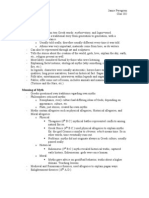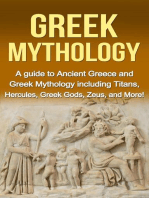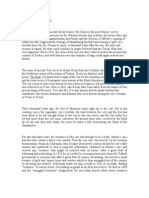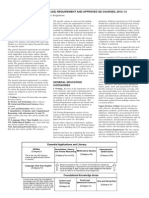Week 2: The Dark Ages: Image Not Shown
Week 2: The Dark Ages: Image Not Shown
Uploaded by
Rohit VashishtCopyright:
Available Formats
Week 2: The Dark Ages: Image Not Shown
Week 2: The Dark Ages: Image Not Shown
Uploaded by
Rohit VashishtOriginal Title
Copyright
Available Formats
Share this document
Did you find this document useful?
Is this content inappropriate?
Copyright:
Available Formats
Week 2: The Dark Ages: Image Not Shown
Week 2: The Dark Ages: Image Not Shown
Uploaded by
Rohit VashishtCopyright:
Available Formats
Week 2: The Dark Ages
Lecture 2, The Origins of the Greek World, 3000-1100, Key Words Minos Linear A Minoans Pithoi Thalassocracy Mycenaeans Pylos Shaft and Beehive Graves Linear B Michael Ventris Wanax Lawagetas Temenos Pasireu Hittites Atreus and Thyestes Seven against Thebes Tiryns Thera Dorian Invasion Codrus Heraclidae Megaron Age of Heroes Epic Tradition
Image not shown due to copyright restrictions
Knossos, Palace, West Magazine: Pithoi
Image not shown due to copyright restrictions
Image not shown due to copyright restrictions
Mycenae: daggers from Shaft Grave
Image not shown due to copyright restrictions
Mycenae: Grave Circle A: Shaft Grave V: Mask of Agamemnon; Gold, 16th century
Chronological Table for Lecture 2
Cretan history Minoan periods
Image not shown due to copyright restrictions
7000-3500 Neolithic period 3500-1100 The Bronze Age 3500-1900 Prepalatial period 2600-1450 Minoan Civilization of Crete 2000 First palaces in Crete 1900-1700 Protopalatial (period of the Old Palaces) 1750-1400 Linear A 1700-1450 Neopalatial (the period of the New Palaces) Knossos, fresco from palace: priest-king 1647-1628 Volcano-island Thera destroyed in an eruption; severe blow to Minoan civilization 1450-1100 Postpalatial (except Final Palace period at Knossos) 1375 Knossos destroyed 1100-1000 The Subminoan period
Mainland Greek history 6500-3000 Neolithic Period; permanent farming villages; domestication of plants and animals; pottery 3000-2100 Early Bronze Age; social ranking emerges; villages and districts ruled by hereditary chiefs 2500 Widespread use of bronze and other metals in the Aegean 2100-1600 Middle Bronze Age 2100-1900 Lerna and other sites destroyed; incursions of Indo-European speakers (arrival of first Greeks) into mainland Greece 1900 Mainland contacts with Crete and the Near East 1600-1100 Late Bronze Age/Mycenaean Age 1450-1200 Linear B 1450 Mycenaean takeover of Crete; Tholos tombs 1450-1200 Height of Mycenaean power and prosperity in Greece (new palaces in Greece) 1250 Trojan War 1200 Invaders loot and burn the palace centers 1200-1100 Destruction of Mycenaean World; palace-system collapses; cultural decline 1200 Fall of Pylos 1150 Fall of Mycenae Image not shown 1100-750 Dark Age; loss of writing due to copyright restrictions 800 Greeks develop an alphabet
Mycenae Gold and Silver: vessels: decorated golden cup
Lecture 3, The Dark Ages and the World of Homer, 1000-750, Key Words Schliemann Milman Parry Polis Wanaktes Achilles Hector Nausicaa Odysseus Priam Thersites Basileis Basileutatos Council (Boule) Assembly (Agora)
Image not shown due to copyright restrictions
Classical Aison, 450-425, Pyxis-lid; Odysseus, Nausicaa
Image not shown due to copyright restrictions Image not shown due to copyright restrictions
Achilles: red figure amphora Achilles painter 445-440 BC
Blinding of Polyphemos by Odysseus and companions, from Etruria, 510-490 BC
The Homeric World and the Bronze Age
BE ABLE TO IDENTIFY: Knossos, Pylos, Mycenae, Linear A, Linear B, wanax, basileus (pasireu), gerousia, lawagetas, demos CONSIDER: 1. What is the value of the Homeric epics as historical sources? For what period(s) are they sources? When were they composed? Over how long a period were they composed? Is there anything about the method of composition (oral formulaic poetry) that would encourage us to expect that they could preserve material significantly earlier than their date of composition? 2. What kinds of evidence do we possess about the Trojan War? What were Homers sources about the Trojan War and the Mycenaean period and how reliable might they have been? Who has better evidence about this period, Homer or we? 3. Analyze the social and political institutions described by Homer. What were the relative powers of the Homeric king, nobility, people? What power is retained by women? 4. Are the institutions described by Homer those of his day or of the late Mycenaean period? Consider the evidence presented by the Linear B tablets. 5. What is the relationship between people and the gods in Homer? Between the individual and the community? Between men and women? What are the values of this community?
Knossos, Palace: Queens Megaron: view into court
Image not shown due to copyright restrictions
Image not shown due to copyright restrictions
Mycenae: Grave Circle A: view
You might also like
- On Justice, Power, and Human Nature Selections From The History of The Peloponnesian War by Thucydides Paul WoodruffDocument228 pagesOn Justice, Power, and Human Nature Selections From The History of The Peloponnesian War by Thucydides Paul WoodruffDaniel J. AnthonyNo ratings yet
- The Class Struggle in The Ancient Greek World From The Archaic Age To The Arab Conquests by Geoffrey E. Maurice Ste. Croix PDFDocument746 pagesThe Class Struggle in The Ancient Greek World From The Archaic Age To The Arab Conquests by Geoffrey E. Maurice Ste. Croix PDFsayuj83100% (2)
- Greek Art and ArchitectureDocument12 pagesGreek Art and Architectureanjali shrivastavaNo ratings yet
- Minoan CivilizationDocument5 pagesMinoan CivilizationTerryNo ratings yet
- AP8 Q2 Module1 Kabihasnang Minoan.. V3Document50 pagesAP8 Q2 Module1 Kabihasnang Minoan.. V3Vnp Vale94% (18)
- CLAS 104 Lec 1 23 PDFDocument890 pagesCLAS 104 Lec 1 23 PDFZainab NasserNo ratings yet
- THE HISTORY OF GREECE (Part 1)Document2 pagesTHE HISTORY OF GREECE (Part 1)ayyash lukmanNo ratings yet
- Introduction To Ancient Mediterranean ArtDocument11 pagesIntroduction To Ancient Mediterranean ArtCaitNo ratings yet
- Egyptian ArchitectureDocument43 pagesEgyptian ArchitecturePrachi Rai Khanal100% (2)
- Formative Period of Greek ArtDocument18 pagesFormative Period of Greek ArtRaphael FelicianoNo ratings yet
- Classical Mythology: Powerpoint OutlinesDocument52 pagesClassical Mythology: Powerpoint OutlinesNena CiciliaNo ratings yet
- The Dark Age ProblemDocument13 pagesThe Dark Age ProblemMattyNo ratings yet
- Mycenaean GreeceDocument29 pagesMycenaean Greecejij66861No ratings yet
- Time To Float: Art Through The Ages ResearchDocument33 pagesTime To Float: Art Through The Ages ResearchChie SierraNo ratings yet
- Dgtal PathwayDocument7 pagesDgtal PathwayKelvin WinataNo ratings yet
- The Mycenaeans: Art, Architecture & HistoryDocument10 pagesThe Mycenaeans: Art, Architecture & HistoryperpetualfatigueNo ratings yet
- A History of the Classical World: The Story of Ancient Greece and RomeFrom EverandA History of the Classical World: The Story of Ancient Greece and RomeNo ratings yet
- Ancient Greece: The World History (His205)Document16 pagesAncient Greece: The World History (His205)salman kabirNo ratings yet
- Ancient Greeks at War: Warfare in the Classical World from Agamemnon to AlexanderFrom EverandAncient Greeks at War: Warfare in the Classical World from Agamemnon to AlexanderNo ratings yet
- Clas 102 Notes 1Document28 pagesClas 102 Notes 1Jenny WoychukNo ratings yet
- Lecture 9 The Greek Civilization The Forming of Greek CivilizationDocument53 pagesLecture 9 The Greek Civilization The Forming of Greek CivilizationIlmiat FarhanaNo ratings yet
- !gods, Heroes and Tyrants, Greek Chronology in ChaosDocument193 pages!gods, Heroes and Tyrants, Greek Chronology in ChaosKamelia Spassova100% (17)
- MyceneDocument15 pagesMyceneAlex AlexNo ratings yet
- D 11 LiteratureDocument14 pagesD 11 LiteratureMohasin Niloy Ahmed 2121497642No ratings yet
- Lecture 03Document38 pagesLecture 03avduongNo ratings yet
- Lecture Notes of Sept 19Document6 pagesLecture Notes of Sept 19Greg LoncaricNo ratings yet
- Greece 8 History Architecture v1 m56577569830517603Document36 pagesGreece 8 History Architecture v1 m56577569830517603Camila GregoskiNo ratings yet
- Crime and Punishment in Ancient Greece and Rome: The University of Western OntarioDocument37 pagesCrime and Punishment in Ancient Greece and Rome: The University of Western OntarioJack SummerhayesNo ratings yet
- Ancient Greek Art Old CivilizationDocument6 pagesAncient Greek Art Old CivilizationJobelle De Vera TayagNo ratings yet
- BNDinh AncientToMedievalArtDocument30 pagesBNDinh AncientToMedievalArtDinh Bui (nguyendinhvn37)No ratings yet
- The Myth of Athenian DemocracyDocument29 pagesThe Myth of Athenian DemocracyJ CooperNo ratings yet
- 2 Greek Civilization PDFDocument64 pages2 Greek Civilization PDFvapilo9457No ratings yet
- Ancient Greek Art Old CivilizationDocument4 pagesAncient Greek Art Old CivilizationJobelle De Vera TayagNo ratings yet
- A Overview of Greek HistoryDocument19 pagesA Overview of Greek Historynetname1100% (1)
- Greek Mythology: A Guide to Ancient Greece and Greek Mythology including Titans, Hercules, Greek Gods, Zeus, and More!From EverandGreek Mythology: A Guide to Ancient Greece and Greek Mythology including Titans, Hercules, Greek Gods, Zeus, and More!No ratings yet
- Greek Civilization PDFchjbuDocument194 pagesGreek Civilization PDFchjbufirst lastNo ratings yet
- The Bronze Age Marked The First Time Humans Started To Work With MetalDocument8 pagesThe Bronze Age Marked The First Time Humans Started To Work With MetalchloeivonneverterraNo ratings yet
- World CivilizationsDocument3 pagesWorld CivilizationsJaya ShankarNo ratings yet
- Greece Is A Country Located in Southeastern EuropeDocument1 pageGreece Is A Country Located in Southeastern EuropeLEAH SANTOSNo ratings yet
- CLA2323 Greek Mythology Timeline of Early Greek HistoryDocument4 pagesCLA2323 Greek Mythology Timeline of Early Greek HistorySarahNo ratings yet
- Starting Around 1200 BCDocument2 pagesStarting Around 1200 BCLaleth Mendoza OjalesNo ratings yet
- Greek Temple Architecture: Doric OrderDocument20 pagesGreek Temple Architecture: Doric OrderSally Marie EscoteNo ratings yet
- ROMAN-FRECO ART HIStoryDocument20 pagesROMAN-FRECO ART HIStoryJeffrey CarduceNo ratings yet
- 2 Greek Civilization PDFDocument64 pages2 Greek Civilization PDFemmantse100% (4)
- Greek Ancient HistoryDocument14 pagesGreek Ancient HistoryNabila T. ChowdhuryNo ratings yet
- Minoans and Mycenaeans EssayDocument16 pagesMinoans and Mycenaeans Essaymat9343No ratings yet
- Classical AntiquityDocument11 pagesClassical Antiquityahmedzommit394No ratings yet
- HIS 144 Final PaperDocument5 pagesHIS 144 Final Papermoomoomilky265No ratings yet
- Classical Civilization of GreeceDocument52 pagesClassical Civilization of GreeceDenisse MarieNo ratings yet
- Classical Antiquity: (Note 1)Document11 pagesClassical Antiquity: (Note 1)SashimiTourloublancNo ratings yet
- Ancient Worlds-The Search For The Origins of Western Civilization-Richard Miles (2010) PDFDocument329 pagesAncient Worlds-The Search For The Origins of Western Civilization-Richard Miles (2010) PDFR.T.100% (3)
- Timeline Ancient GreeceDocument4 pagesTimeline Ancient GreeceSasha KovalevaNo ratings yet
- The City of TroyDocument3 pagesThe City of TroyEdward L Hester0% (1)
- Ancient GreeceDocument39 pagesAncient GreeceSantiago Zurita100% (2)
- Minoan SocietyDocument24 pagesMinoan SocietystvnNo ratings yet
- Historical Background (Lecture 1 Slides)Document3 pagesHistorical Background (Lecture 1 Slides)Jeonghun LeeNo ratings yet
- Crime and Punishment FinalDocument119 pagesCrime and Punishment FinalPaige LoveckyNo ratings yet
- Iron Age CivilizationDocument48 pagesIron Age CivilizationThulla SupriyaNo ratings yet
- Ancient GreeceDocument31 pagesAncient GreeceAnisoara Marc100% (1)
- Greek Cities and GodsDocument1 pageGreek Cities and Godsmadnick21No ratings yet
- Greek Vases Preset 1Document29 pagesGreek Vases Preset 1Anonymous gWbjDeNo ratings yet
- Quiz 1Document3 pagesQuiz 13 name changes allowed every 90 daysNo ratings yet
- History of Gymnastics and Ancient History of GymnasticsDocument1 pageHistory of Gymnastics and Ancient History of GymnasticsJ-zeil Oliamot PelayoNo ratings yet
- Ssi 1ST Term Phy Educ E-NotesDocument25 pagesSsi 1ST Term Phy Educ E-Notespalmer okiemuteNo ratings yet
- Herodotus Thucydides NotesDocument14 pagesHerodotus Thucydides NotesEmilee TuNo ratings yet
- Mankind Episodes1 12 1Document97 pagesMankind Episodes1 12 1Ramojifly LinganNo ratings yet
- General Bibliography About Alexander The GreatDocument3 pagesGeneral Bibliography About Alexander The GreatPezanosNo ratings yet
- The Evolution of International RelationsDocument16 pagesThe Evolution of International RelationsAllan DavidNo ratings yet
- 79 Passage 3 - Coinage in Ancient Greece Q28-40Document5 pages79 Passage 3 - Coinage in Ancient Greece Q28-40gngocvux12No ratings yet
- Mimnermus - Oxford Classical DictionaryDocument2 pagesMimnermus - Oxford Classical DictionaryÍvina GuimarãesNo ratings yet
- A History of Philosophic Ideas About SportDocument21 pagesA History of Philosophic Ideas About SportEmmanuel Estrada AvilaNo ratings yet
- HistoriographyDocument19 pagesHistoriographyGB Pranav LalNo ratings yet
- The Leading Edge: Victor Serebriakoff and Isaac AsimovDocument9 pagesThe Leading Edge: Victor Serebriakoff and Isaac Asimovpedronuno20No ratings yet
- What Are The Contributions of Greek To Modern Education?Document9 pagesWhat Are The Contributions of Greek To Modern Education?Zubaida Umar AhmedNo ratings yet
- Etruscans Italy S Lovers of Life PDFDocument176 pagesEtruscans Italy S Lovers of Life PDFTemirbek Bolot100% (1)
- 13th Seminar On Olympic Studies For Postgraduate Students 37933-600-2Document600 pages13th Seminar On Olympic Studies For Postgraduate Students 37933-600-2umityilmazNo ratings yet
- Lysistrata LitChartDocument27 pagesLysistrata LitChartBrian AnderssonNo ratings yet
- Way of HeathenDocument15 pagesWay of HeathenGillesNo ratings yet
- The Comedies Aristophanes (Vol 1)Document610 pagesThe Comedies Aristophanes (Vol 1)somebody535No ratings yet
- Lang, OstrakaDocument252 pagesLang, OstrakaJulian Gallego100% (1)
- Grade 3 Social Studies Sol Review SheetDocument4 pagesGrade 3 Social Studies Sol Review Sheetapi-266054865No ratings yet
- 18 The Language of Non, Athenians in Old Come, DyDocument14 pages18 The Language of Non, Athenians in Old Come, Dystrajder7No ratings yet
- Slavery in Ancient IndiaDocument18 pagesSlavery in Ancient IndiakalashNo ratings yet
- Greek Theatre & Greek Tragedy: DR T Jeevan KumarDocument17 pagesGreek Theatre & Greek Tragedy: DR T Jeevan KumarErlena MiradorNo ratings yet
- NOTES For Greek RationalismDocument18 pagesNOTES For Greek RationalismJsyl Flor ReservaNo ratings yet
- UCI GE RequirementDocument9 pagesUCI GE Requirementam2567323No ratings yet

























































































